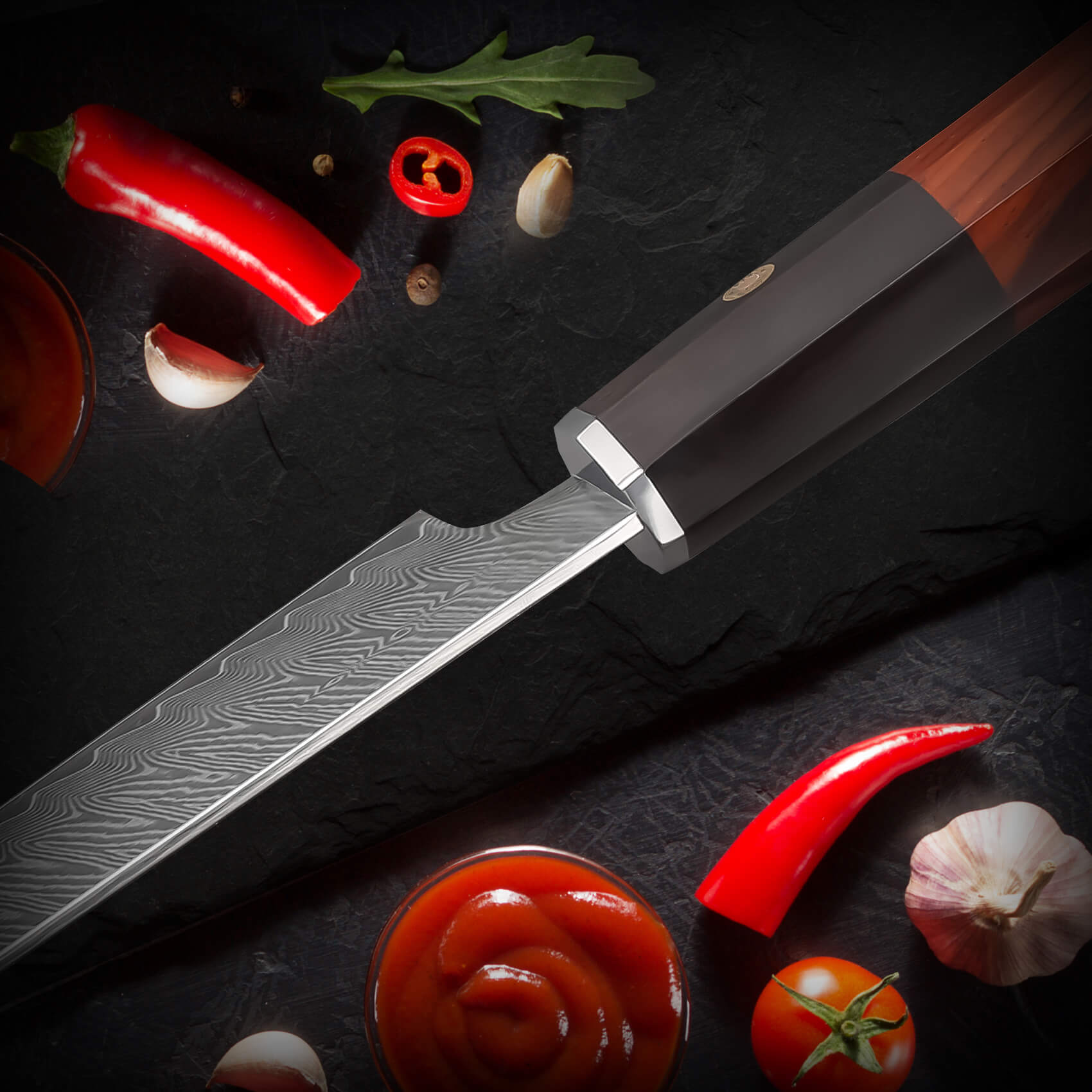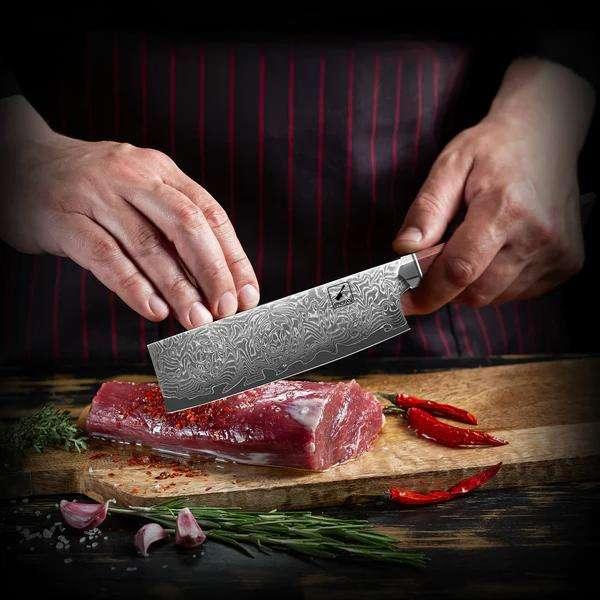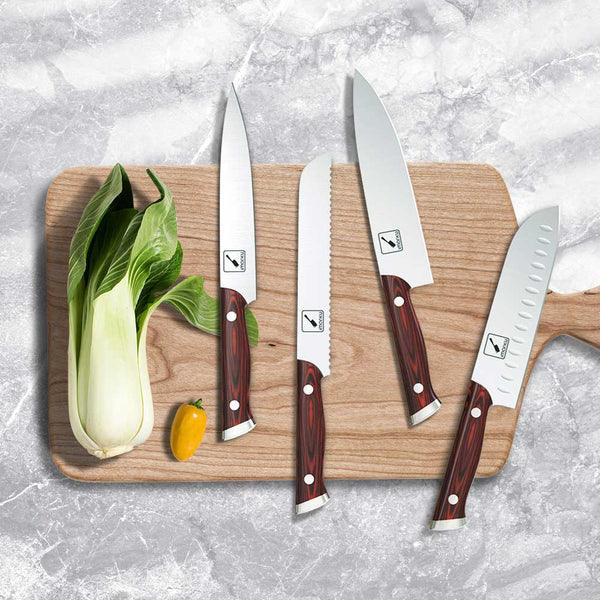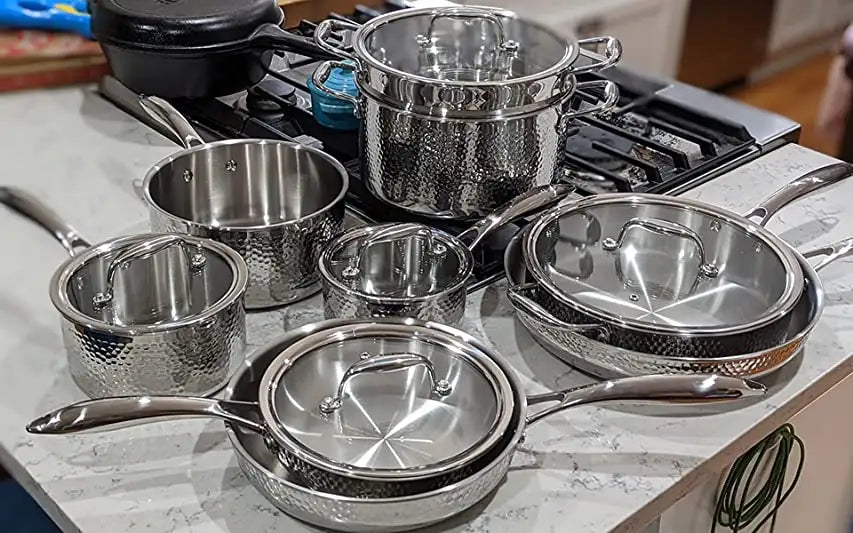TABLE OF CONTENTS
Damascus steel tops the competition due to its reliability, reputation, quality, and sharpness. Users appreciate the beautiful and wavy pattern of a Damascus knife.
In the following article, you will know about the material and compare it with other materials. Also, we will cover the top three recommendations. In the end, we will answer your queries. Keep reading if you want to know more about the Damascus knife.

What Is A Damascus Knife?
A Damascus knife uses a Damascus steel blade. The material gives a wavy pattern design to your knife. Also, it is flexible and maintains a sharp edge for a long time. The blade has its origin in the Asian and European sword smithery.
The material is durable, and its distinct pattern offers a unique appearance to the knife. It combines advanced functionality and an appealing look to become the first choice for commercial and personal usages.
The blade of this knife will have a wavy surface pattern after repeated heating and forging. Even if these knives have been around from ancient civilization, they have witnessed some modifications in the recent past.
Now, they are folded and refolded with one kind of steel or forged-welded with different steels. You can expect a unique pattern in both these methods.

How Damascus Steel Got Its Name
Damascus steel has a rich history that dates back to 800-873 CE. Some believe that it got this name from two Islamic scholars. They are Al-Biruni and Al-Kindi, and they gave this name based on their geographical location and appearance.
In their writings, they mentioned Damascus or damascene to describe the swords. However, there are many other stories about the name and origin of the Damascus steel.
If you go to the history back to thousands of years, you will come to know that the blacksmiths of Damascus city were well-known for their unique steel fabrication techniques. However, they focused on heating and folding to get a strong blade and impressive appearance. Both the look and functionality were spectacular. These blades had a reputation for maintaining the edges for a long time. Besides, they were not prone to damage and chipping.
In addition to all these, there is a sensible explanation behind the name. Some believe that the steel has got its name from Damascus, the capital of Syria.

How Damascus Knives Are Made
The original Damascus steel has gone through many changes over the years. The modern Damascus steel uses two methods during the making. It involves the forge-welding of different steels before twisting, beating, and manipulating the metal. Another way of making this steel is to flatten out and fold a single type of steel to create metal layers.
Both these methods will produce organic patterns in Damascus knives. The current techniques focus on the aesthetically appealing look.
However, the folding and refolding processes will have some benefits. They will purify the metal and can help with better results. Also, acid etching can create a unique pattern.
If you compare modern and traditional Damascus steel, you will find a lot of differences. Yes, the ancient method of making has lost its significance. However, it was well-appreciated for its durability and strength. The material had a type of steel (Wootz steel) available in India.

What To Look For When Shopping For A Damascus Knife
You will find unlimited options in the Damascus knives. The wide availability can confuse any. Hence, you will have to check the following buying considerations before going ahead.
Sturdiness
The sturdiness will be a determining factor. This material features extraordinary hardness to last long and hold the edge for a long time.
Execution
Damascus knives hold the sharpness longer than other materials. They will have a compact edge to ensure efficient functionality.
Budget
Damascus options are more expensive compared to other kitchen knives. Hence, you will have to spend more on quality and improved functionality.

How To Spot A Fake Damascus Knife
Now, you know how to find a reliable Damascus knife. Next, we will help you to recognize a fake knife. You can check the following to differentiate between an original and fake Damascus knife.
Pattern
You can check the pattern to know the difference. It is the easiest way to find an original product. If you find an identical wavy pattern on all knives, they are not original.
However, while buying them individually, you can check the design. If it looks unnatural and weird-shaped, then it is not Damascus. Also, imitated options will have high contrast between dark and light spots.
Geometry
In addition to the pattern, you will have to check geometry. In Damascus knives, the design will be present throughout. Yes, if there is a consistent wavy style all over, it is Damascus steel. However, if the pattern is on the surface only, it might be a fake knife.

Differences Between Damascus Knives vs. Carbon Steel Knives
You will find differences in the composition, texture, appearance, and price. The material of Damascus steel focuses on forging iron, steel alloys, and steel together. But the carbon steel is hard and features better edge retention. When it comes to the texture, Damascus will have patterns all over. The design will look like swirls or waves. The carbon steel will look simple, practical, and more modern. Besides, you will have to spend more on Damascus knives than carbon steel.
In appearance, Damascus gets preference due to the patterns. However, carbon steel knives does not look that impressive and might be the best option for those looking for an appealing appearance.

Differences Between Damascus Steel Knives vs. Stainless Steel Knives
While comparing these two knives, you will have to check the composition, appearance, functionality, and budget. Both these knives are not similar in many aspects. The Damascus uses forged steel, and the stainless steel uses alloy and iron. Even if it is sturdier than iron, it is prone to corrosion. Also, stainless steel knives will have a shiny surface. However, Damascus knives will look beautiful with swirl and wavy patterns.
When it comes to functionality, Damascus is the best material for knives. However, stainless steel is versatile. You will find many kitchen appliances in stainless steel material. Both these materials are resistant to corrosion. However, stainless steel uses 10-30% chromium to get this benefit. Both these knives share some similar benefits. They offer maximum edge retention, flexibility, and durability.

Damascus Knife Recommendations
You will need a sharp and sturdy Damascus knife to meet the different cutting needs of your kitchen. As mentioned earlier, there will be unlimited options in Damascus knives.
However, you will have to find the best one for your use. In addition to the appearance, you will have to focus on the functionality. You will have to make sure that the knife is versatile and holds the edge for a long time. Besides, you will have to ensure easy usage and super durability.
Are you a bit confused? Do you want to know how to find the best one? We will make it easier for you in the following.
Kiritsuke Knife

You can expect super versatility and top-cutting performance from the Kiritsuke chef knife. Also, you can use this knife to cut vegetables at ease. All the credit goes to its sharpness. It has slightly curved edges that offer extra rocking motion while slicing your cooked meats.
You can cut whatever you want. It is sharp, sturdy, and incredibly durable. Also, it can meet most of your cutting needs. Its blade hardness is HRC 60±2, and it uses a double-edged blade to ensure smooth cutting. It will offer the best cutting support to both right-handed and left-handed users.
The blade length of this knife is eight inches, and it uses VG10 Stainless Steel Core or Damascus 67 layers blade. The handle material is premium rosewood, and it offers a firm and safe grip.
Pros
- Versatile and can support different cutting needs
- The blade is easy to clean and maintain
- Offers desired sharpness
- Holds the edges for a long
- Quality steel and incredible hard
- Curved edges to ensure effortless cutting
Cons
- Cannot cut bones or frozen products
- Not dishwasher safe
Nakiri Knife

It is a professional-level knife that you can use in your kitchen. It is incredibly versatile and can be your best cutting companion. You will love the eye-catching design and improved functionality. Like the previous one, this blade will have curved edges. The edges will help with an extra rocking motion.
As a result, you can slice your cooked meats fast and effortlessly. Also, this knife is durable and can serve you for a long time. You will not have to spend on the replacement. Instead, you can sharpen its edges whenever needed to bring back the functionality.
Its VG-10 stainless steel core blade can offer improved hardness and toughness. Also, the material is corrosion-resistant. You can clean your knife easily as well. In brief, it will serve you for years with minimal maintenance. You can expect better value and hardness. Besides, most users find this knife worth spending.
Pros
- VG10 Stainless Steel Core to offer the desired stability
- Double-edged feature to ensure smooth cutting
- Best for different cutting needs
- Durable and quality made handle
- Easy to sharpen the blade
Cons
- Not suitable for frozen products
- It might not be the best for delicate jobs
Boning Knife

You can go with this knife if you want something exceptional to cut your meat. Yes, it is the best knife to separate meat from bones. Its blade is sharp, and you can use it for almost all types of cutting in your kitchen. The sharp blade can cut everything at ease.
You can smoothly glide it along with the surface. You can get the best cutting without any hassle. Also, it features a unique curve that can slice through tough fibers easily. In brief, your effort will be minimal while doing any cutting tasks.
While buying a knife, you will prefer a firm and stable grip. Yes, this one has a quality-made and durable handle. Also, the material of the handle is premium rosewood.
It uses the VG10 Stainless Steel Core blade, and the hardness of the blade is HRC 60±2. The blade length is 5-5 inches. When it comes to the maintenance requirements, you can use warm water and wipe your knife with a towel. With this simple upkeep, you can use your knife for a long. More importantly, you can sharpen it whenever needed at your home.
Pros
- Sharp edges make it the best choice to cut meats
- Durable and easy to maintain
- Can meet different cutting needs
- Improved functionality and quality material
- The handle ensures a safe and firm grip
- It looks appealing and eye-catching
Cons
- You might find the size a bit small
- A bit expensive
Now you have the top three Damascus knives. All have a good reputation for durability, functionality, and easy usage. You can check the features and price and match them with your purpose to find the most suitable one.
You can expect super durability and incredible performance from all of them. Also, they are easy to maintain. You can wash them with water and wipe them with a towel. It will clean all the deposits.
Frequently Asked Questions About Damascus Knives

What Makes Damascus Knives Special?
The blade and the pattern make these knives different from their competitors. The steel and the making process give a unique wavy style to this knife. You cannot expect the same design on other products.
Yes, these knives are well-appreciated for their aesthetically appealing look and sleek appearance. Also, they are flexible and sturdy. The maintenance requirements will be minimal as well. Besides, they will hold the edges for a long. You might not expect all these benefits from other leading names.
How Much Will Damascus Cost?
When it comes to the price, you will have to spend a bit more. These knives are expensive than other available options. You can blame the quality, improved functionality, and unique design for the price. But you can use your knife for years, and you will not have to spend on replacements. However, you will have both expensive and less expensive options. You can find one for $30, and it can go up to $200 or more as well.






















Leave a comment
All comments are moderated before being published.
This site is protected by hCaptcha and the hCaptcha Privacy Policy and Terms of Service apply.